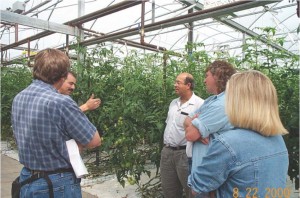As 12 people were sickened with influenza A (H3N2) variant from contact with pigs at petting zoos last week and four outbreaks linked with mail-order chicks that have sickened hundreds with Salmonella, primarily children, Kanssas State researchers are warning that interactions between animals and the public need better oversight,
“People have to be careful, and a lot more careful than they thought, “ said Dr. Douglas Powell a professor of food safety at Kansas State University. “That’s what I told my 3-year-old’s daycare as they prepared for a chicken coop. I’m not sure people like that message.”
Gonzalo Erdozain, a veterinary and Masters of Public Health student who works with Powell, lead the study and visited numerous petting zoos and fairs in Kansas and Missouri in 2010 and .jpg) 2011. Erdozain found many sanitary problems at the facilities..
2011. Erdozain found many sanitary problems at the facilities..
The other authors were Katherine KuKanich of Kansas State and Ben Chapman of North Carolina State University.
Scott Weese, an OK hockey player, veterinarian, and author of the Worms & Germs Blog first published the news our paper was public.
A recent study in Zoonoses and Public Health by Erdozain et al 2012 (under the guidance of Doug Powell and Ben Chapman of barfblog fame…or infamy, I guess, if you’re particularly slack regulator or politician) evaluated petting zoos in Kansas and Missouri in 2010-2011.
They focused on behaviours or factors that would be associated with public health risks, and found:
Handwashing station and signs were present at the exit of 7/13 petting zoos. Yes, it means the majority had them but it’s a pretty disappointing number. It’s easy to do and there’s no excuse for not having proper hand hygiene station at the exit. The other 6 at least had hand hygiene stations within or near animal contact areas, but that’s not ideal. People need to be able to clean their hands on the way out. Doing it in the middle doesn’t help much, and if people have to go out of the way to perform hand hygiene after leaving, it will rarely get done.
At one event, there was only a sink with no soap, and at another, 2/3 hand sanitizers were empty and there was no area to wash hands. Having hand hygiene facilities is only useful if they are actually appropriately stocked.
Signs encouraging hand washing were present at the exit of 10/13 petting zoos, but signs were present at the entrance or entrance to eating areas.
Staff were present monitoring activities in only 6/13 events. At one unsupervised facility, kid goats were able to escape through the fence and were roaming freely.
When they observed people, they saw that only 37% of visitors washed their hands or used a hand sanitizer when leaving. That’s not really surprising but it’s disappointing nonetheless. People are skipping what is typically the biggest risk factor for pathogen transmission in petting zoos.
Visitors were almost 5 times as likely to wash their hands when a staff member was present. That’s consistent with a study we published last year and shows the importance of a little encouragement.
High-risk animals were present in some petting zoos. That includes chicks, young ruminants (kid goats) and, a new one for me, a petting zoo that allowed people to enter an area and pet and sit with tortoises.
People were allowed into animal enclosures in 7 petting zoos, and not surprising, fecal contamination of the ground was common (petting zoo animals not being house trained).
Various behaviors that might increase the risk of disease were observed, including kids (the human kind, not the goat kind) touching their faces (77% of events), kids eating or drinking in the petting zoo (15% and 38%, respectively), kids eating petting zoo food (7%) and kids sucking on pacifiers (23%). Children were also seen picking up animal feces at one event.
Overall, despite the lessons that should have been learned from various outbreaks, numerous deficiencies were present, including many that would take little effort to rectify.
The state of petting zoos, at least around here, has certainly improved over the past decade, in part due to more attention from location public health officials, but how do we get more, sustained and widespread improvement?
More strict governmental regulation and enforcement is one way, but that tends to be slow. The more effective approach is probably one that involves the almighty dollar. Most petting zoos are there to make money or bring people to a broader event that makes money. Like many issues, if consumers start demanding change, change will occur quickly. Maybe that’s easier said than done, but the more pressure that’s put on petting zoo operators and people that run events .jpg) where petting zoos are present, the more likely it is that change will occur. Petting zoos can be great opportunities, particularly for kids, but we need to make them as safe as possible. Providing hand hygiene stations, some good signs, having staff supervise, avoiding high-risk animals and logical facility design are easy and inexpensive, and not doing so is inexcusable.
where petting zoos are present, the more likely it is that change will occur. Petting zoos can be great opportunities, particularly for kids, but we need to make them as safe as possible. Providing hand hygiene stations, some good signs, having staff supervise, avoiding high-risk animals and logical facility design are easy and inexpensive, and not doing so is inexcusable.
That means, parents, rather than just sending your kids on the latest self-funded school trip, be sure to ask questions about where the kids are going when they visit the animals.
A table of petting zoo outbreaks is available at http://bites.ksu.edu/petting-zoos-outbreaks.
Abstract below:
Observation of public health risk behaviors, risk communication and hand hygiene at Kansas and Missouri petting zoos – 2010-2011Outbreaks of human illness have been linked to visiting settings with animal contact throughout developed countries. This paper details an observational study of hand hygiene tool availability and recommendations; frequency of risky behavior; and, handwashing attempts by visitors in Kansas (9) and Missouri (4), U.S., petting zoos. Handwashing signs and hand hygiene stations were available at the exit of animal-contact areas in 10/13 and 8/13 petting zoos respectively. Risky behaviors were observed being performed at all petting zoos by at least one visitor. Frequently observed behaviors were: children (10/13 petting zoos) and adults (9/13 petting zoos) touching hands to face within animal-contact areas; animals licking children’s and adults’ hands (7/13 and 4/13 petting zoos, respectively); and children and adults drinking within animal-contact areas (5/13 petting zoos each). Of 574 visitors observed for hand hygiene when exiting animal-contact areas, 37% (n=214) of individuals attempted some type of hand hygiene, with male adults, female adults, and children attempting at similar rates (32%, 40%, and 37% respectively). Visitors were 4.8x more likely to wash their hands when a staff member was present within or at the exit to the animal-contact area (136/231, 59%) than when no staff member was present (78/343, 23%; p<0.001, OR=4.863, 95% C.I.=3.380-6.998). Visitors at zoos with a fence as a partial barrier to human-animal contact were 2.3x more likely to wash their hands (188/460, 40.9%) than visitors allowed to enter the animals’ yard for contact (26/114, 22.8%; p<0.001, OR= 2.339, 95% CI= 1.454-3.763). Inconsistencies existed in tool availability, signage, and supervision of animal-contact. Risk communication was poor, with few petting zoos outlining risks associated with animal-contact, or providing recommendations for precautions to be taken to reduce these risks.
 refrigeration has allowed humans to preserve food and, with it, nutrition. It has also allowed for a key innovation in human civilization: cold beer.
refrigeration has allowed humans to preserve food and, with it, nutrition. It has also allowed for a key innovation in human civilization: cold beer.






.jpg) industry standard for the handling of animals."
industry standard for the handling of animals.".jpg) in Kentucky and sickened 178 people in 21 states.
in Kentucky and sickened 178 people in 21 states..jpg) scrutiny.
scrutiny.(2).jpeg)
 meaning restaurants that violate regulations face the threat of lost business.)
meaning restaurants that violate regulations face the threat of lost business.).jpg) 2011. Erdozain found many sanitary problems at the facilities..
2011. Erdozain found many sanitary problems at the facilities...jpg) where petting zoos are present, the more likely it is that change will occur. Petting zoos can be great opportunities, particularly for kids, but we need to make them as safe as possible. Providing hand hygiene stations, some good signs, having staff supervise, avoiding high-risk animals and logical facility design are easy and inexpensive, and not doing so is inexcusable.
where petting zoos are present, the more likely it is that change will occur. Petting zoos can be great opportunities, particularly for kids, but we need to make them as safe as possible. Providing hand hygiene stations, some good signs, having staff supervise, avoiding high-risk animals and logical facility design are easy and inexpensive, and not doing so is inexcusable..jpg) supposed to say. Observation, direct or indirect, is much more powerful.
supposed to say. Observation, direct or indirect, is much more powerful..jpeg) Insert food safety in places to this piece below from
Insert food safety in places to this piece below from .jpeg) and the nearly limitless competition supplied by the web. Unsurprisingly, micropayments have been a hot topic in the news industry over the past few years. But so far, they haven’t really taken off.
and the nearly limitless competition supplied by the web. Unsurprisingly, micropayments have been a hot topic in the news industry over the past few years. But so far, they haven’t really taken off.